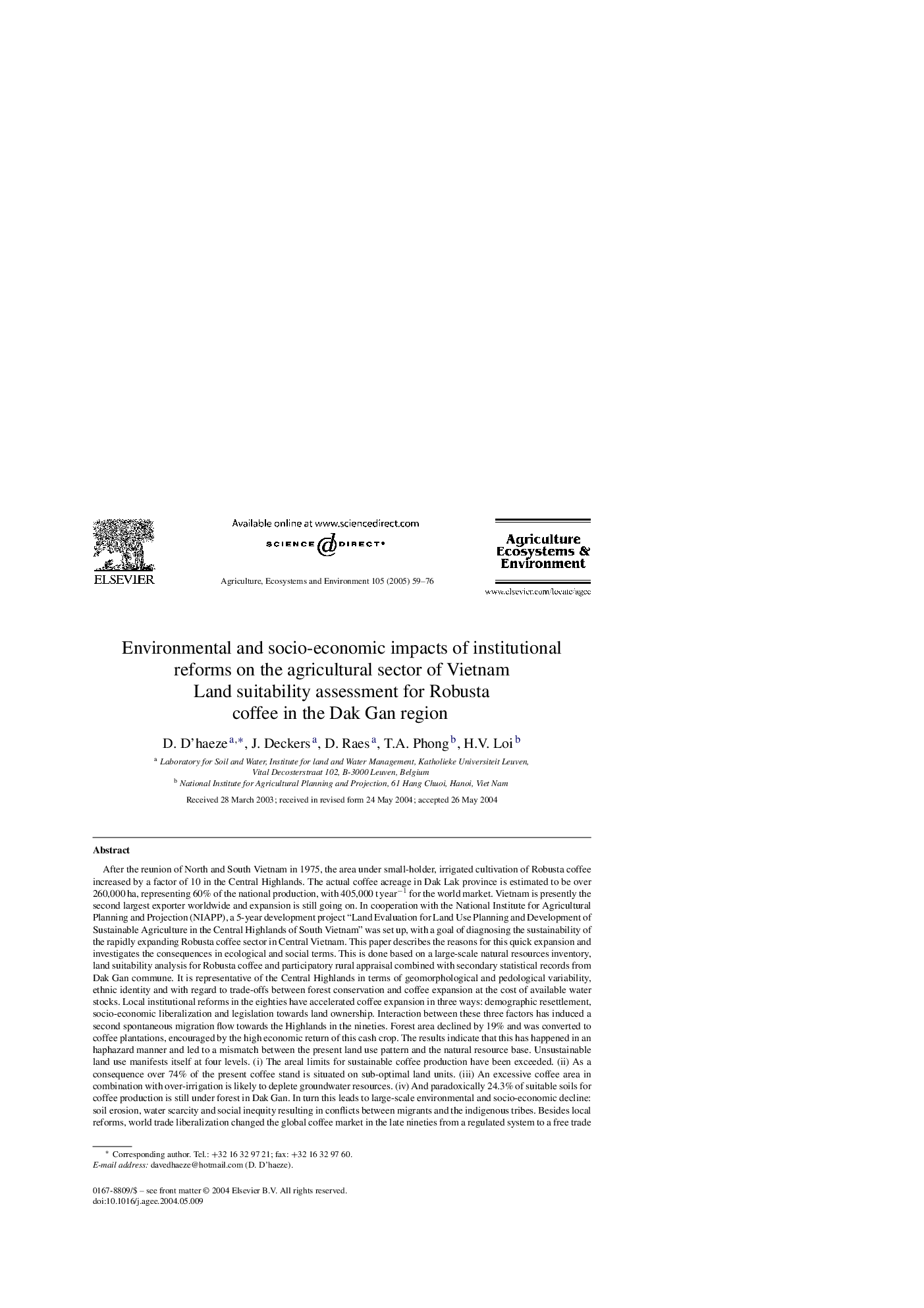| کد مقاله | کد نشریه | سال انتشار | مقاله انگلیسی | نسخه تمام متن |
|---|---|---|---|---|
| 8970879 | 1552159 | 2005 | 18 صفحه PDF | دانلود رایگان |
عنوان انگلیسی مقاله ISI
Environmental and socio-economic impacts of institutional reforms on the agricultural sector of Vietnam
دانلود مقاله + سفارش ترجمه
دانلود مقاله ISI انگلیسی
رایگان برای ایرانیان
کلمات کلیدی
موضوعات مرتبط
علوم زیستی و بیوفناوری
علوم کشاورزی و بیولوژیک
علوم زراعت و اصلاح نباتات
پیش نمایش صفحه اول مقاله

چکیده انگلیسی
After the reunion of North and South Vietnam in 1975, the area under small-holder, irrigated cultivation of Robusta coffee increased by a factor of 10 in the Central Highlands. The actual coffee acreage in Dak Lak province is estimated to be over 260,000 ha, representing 60% of the national production, with 405,000 t yearâ1 for the world market. Vietnam is presently the second largest exporter worldwide and expansion is still going on. In cooperation with the National Institute for Agricultural Planning and Projection (NIAPP), a 5-year development project “Land Evaluation for Land Use Planning and Development of Sustainable Agriculture in the Central Highlands of South Vietnam” was set up, with a goal of diagnosing the sustainability of the rapidly expanding Robusta coffee sector in Central Vietnam. This paper describes the reasons for this quick expansion and investigates the consequences in ecological and social terms. This is done based on a large-scale natural resources inventory, land suitability analysis for Robusta coffee and participatory rural appraisal combined with secondary statistical records from Dak Gan commune. It is representative of the Central Highlands in terms of geomorphological and pedological variability, ethnic identity and with regard to trade-offs between forest conservation and coffee expansion at the cost of available water stocks. Local institutional reforms in the eighties have accelerated coffee expansion in three ways: demographic resettlement, socio-economic liberalization and legislation towards land ownership. Interaction between these three factors has induced a second spontaneous migration flow towards the Highlands in the nineties. Forest area declined by 19% and was converted to coffee plantations, encouraged by the high economic return of this cash crop. The results indicate that this has happened in an haphazard manner and led to a mismatch between the present land use pattern and the natural resource base. Unsustainable land use manifests itself at four levels. (i) The areal limits for sustainable coffee production have been exceeded. (ii) As a consequence over 74% of the present coffee stand is situated on sub-optimal land units. (iii) An excessive coffee area in combination with over-irrigation is likely to deplete groundwater resources. (iv) And paradoxically 24.3% of suitable soils for coffee production is still under forest in Dak Gan. In turn this leads to large-scale environmental and socio-economic decline: soil erosion, water scarcity and social inequity resulting in conflicts between migrants and the indigenous tribes. Besides local reforms, world trade liberalization changed the global coffee market in the late nineties from a regulated system to a free trade market. This fostered global oversupply, which in combination with a stagnant coffee demand suppressed the world market price. Since Vietnam became the second world producer of Robusta, prices have declined by a factor of 3, not only affecting the local sector but households worldwide.
ناشر
Database: Elsevier - ScienceDirect (ساینس دایرکت)
Journal: Agriculture, Ecosystems & Environment - Volume 105, Issues 1â2, January 2005, Pages 59-76
Journal: Agriculture, Ecosystems & Environment - Volume 105, Issues 1â2, January 2005, Pages 59-76
نویسندگان
D. D'haeze, J. Deckers, D. Raes, T.A. Phong, H.V. Loi,